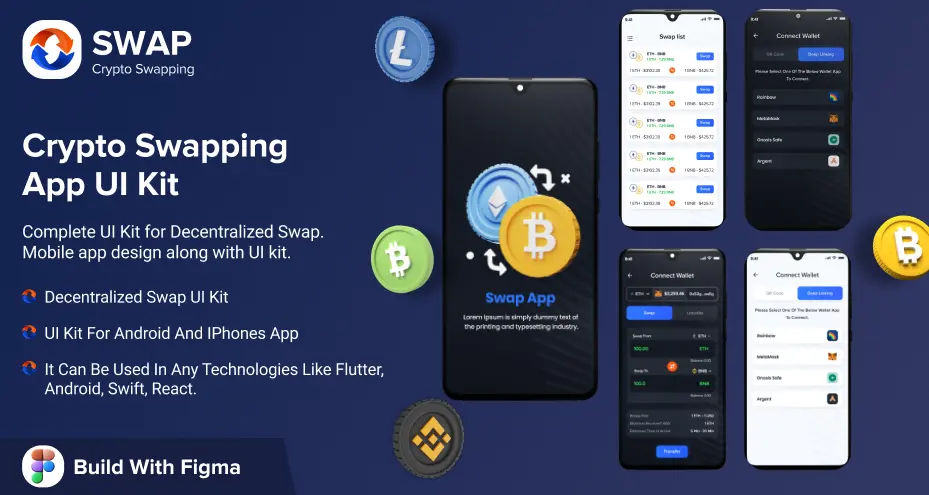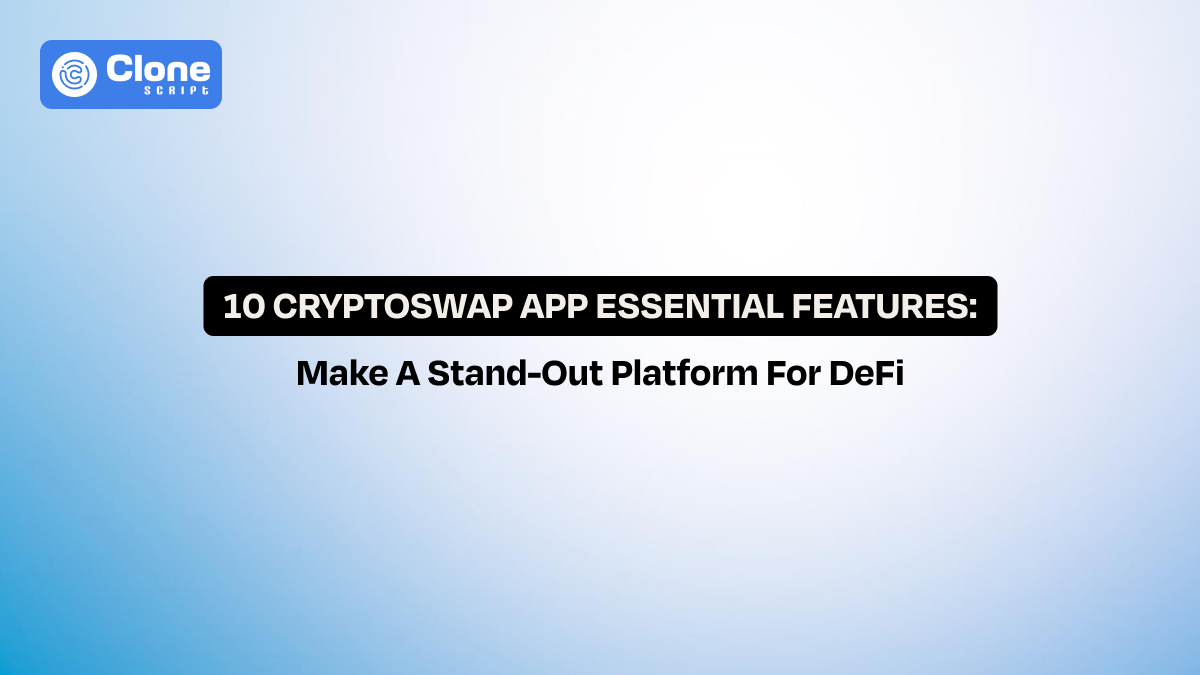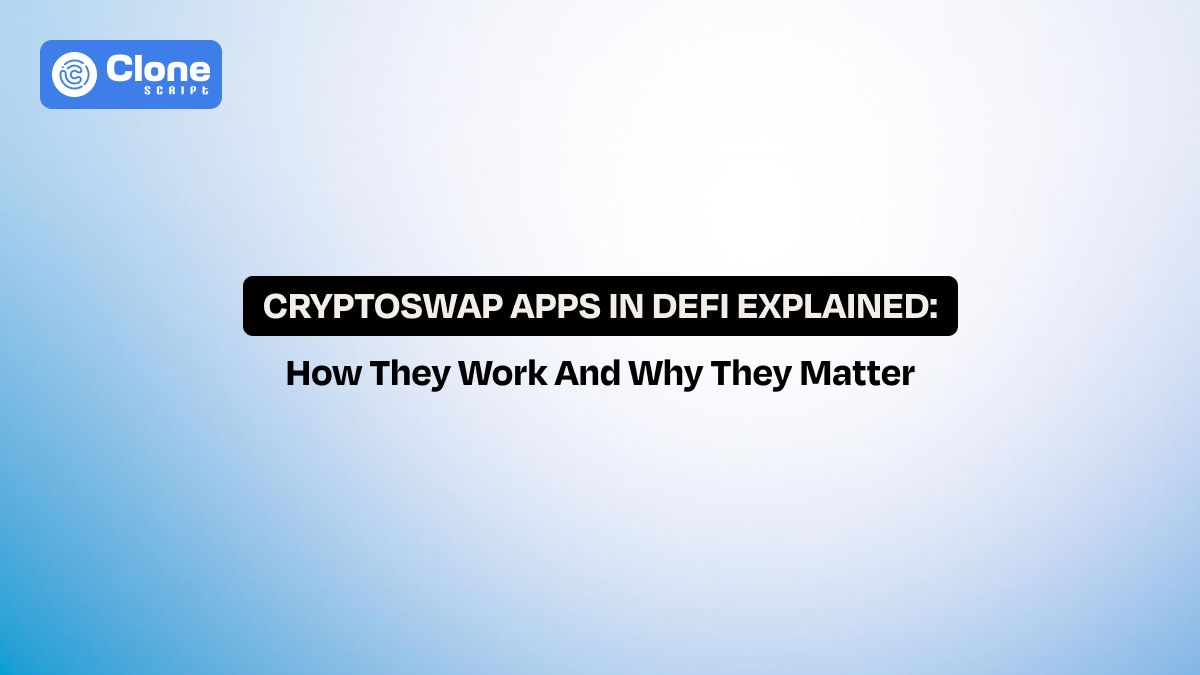10 Essential Features That Make a Crypto Swap App Stand Out
In 2025, decentralized crypto swapping has overtaken traditional exchanges, with platforms like Uniswap and PancakeSwap collectively processing over $150 billion in monthly volume. Users today no longer tolerate delays, hidden fees, or complex interfaces. They want instant, transparent, and secure swaps from their mobile wallets.
For developers, this shift isn’t just a trend; it’s a call to build smarter, faster, and more user-friendly token swap apps. A successful crypto swap app isn’t defined by how many tokens it supports, but by how smoothly users can trade, track prices, and manage assets in real time.
This blog explores the core features that make a crypto swap app stand out — from cross-chain compatibility and liquidity pool integration to security audits and analytics dashboard. It helps developers design platforms that win user trust and stay ahead in the DeFi evolution.
Why Do You Need to Provide User-Friendly Features in Crypto Apps?
In today’s DeFi ecosystem, user experience (UX) is non-negotiable as it’s the foundation of trust. Crypto users are skeptical, and they now expect simplicity, speed, and transparency similar to modern fintech apps like PayPal or Revolut. If your crypto swap app feels complicated or unreliable, users will leave before making their first trade.
-
Data supports this shift: according to Chainalysis' 2025 reports, over 68% of new crypto users prefer decentralized apps (dApps) that offer clear interfaces and instant transactions.
Developers who prioritize ease of use, intuitive navigation, and real-time feedback see significantly higher retention and transaction volumes.
In short, a user-friendly design doesn’t just improve usability. It drives trust, engagement, and long-term loyalty. Whether it’s a one-click swap, transparent fee breakdown, or fast wallet integration, every feature should make the crypto journey seamless and confident for both new and expert users.
CryptoSwap App Features to Look Out For
Here’s a list of the most unique features that make the app different for users:
-
Quick and Seamless Token Swaps
-
Wallet Integration with Multiple Options
-
Real-Time Price Tracking and Market Data
-
Liquidity Pool and AMM Support
-
Transparent Fees and Slippage Control
-
Top-Level Security And Contract Audits
-
Intuitive Dashboard and Mobile-Friendly Design
-
Cross-Chain Compatibility
-
Multi-Language and Localization Support
-
Performance Analytics and Insights
Let’s understand them.
1. Quick and Seamless Token Swaps
In crypto trading, every second counts. Users don’t just expect fast transactions — they demand them. By 2025, decentralized wallets will be facilitating over 20 million token swaps every week, according to The Coinomist. This marks a tenfold increase since 2021.
This explosive growth reflects one clear fact: speed and reliability define trust in a crypto swap app.
Even leading platforms like MetaMask Swaps have reported over $34 billion in processed swap volume by late 2024 (as per Social Capital Markets), a 17% year-over-year rise. It shows how crucial seamless, one-tap token exchanges have become to user satisfaction.
Why It Matters
-
High-speed execution = user trust. Apps completing swaps in seconds retain more users and generate higher daily activity.
-
Low slippage builds transparency. Consistent pricing during swaps reassures users that their trades are fair.
-
Reliability fuels loyalty. If swaps fail or are often, users instantly migrate to faster competitors.
Developer Priorities
To deliver fast and seamless swaps, developers should:
-
Integrate DEX aggregators (like 1inch, Matcha, or Paraswap) for real-time price routing.
-
Display precise gas fee estimates and expected transaction times.
-
Implement fallback routing when a liquidity source fails, ensuring no swap interruption.
-
Enable one-click confirmation for frequent or repeat swaps.
-
Maintain backend performance monitoring to minimize latency and failed transactions.
In decentralized finance, speed is more than a feature — it’s your brand reputation. The best crypto swap apps win users not by flashy design, but by delivering swaps that execute flawlessly, every single time.
2. Wallet Integration with Multiple Options
In 2025, 78% of cryptocurrency users report using hot wallets as their primary storage solution, with 72% preferring mobile-first solutions. This trend underscores the necessity for crypto swap apps to offer seamless integration with a variety of wallets, including popular options like MetaMask, Trust Wallet, and Coinbase Wallet.
Why It Matters
-
User Preference: Users are more likely to engage with platforms that support their preferred wallets and enhancing user experience and retention.
-
Market Reach: Supporting multiple wallets broadens your app's accessibility, catering to a diverse user base across different platforms and devices.
-
Security and Control: Offering a range of wallet options allows users to choose the level of security and control they desire over their assets.
Developer Priorities
To effectively integrate multiple wallet options:
-
Implement WalletConnect: This open-source protocol facilitates secure connections between your app and various wallets to improve compatibility and user trust.
-
Support Multiple Platforms: Ensure your app is compatible with both mobile and desktop versions of popular wallets. It is important to accommodate users across devices.
-
Provide Clear Instructions: Offer easy-to-follow guides for users on how to connect their wallets to your app. This minimized frustration and potential confusion.
By prioritizing comprehensive wallet integration, developers can create a more inclusive and user-friendly crypto swap app. It meets the diverse needs of the modern crypto community.
3. Real-Time Price Tracking and Market Data
In crypto, users expect accurate, real-time market data when making swaps. According to Messari Research (2025), over 65% of active DeFi users check token prices multiple times per day before executing trades. A crypto swap app that fails to provide up-to-date pricing risks losing users to competitors offering transparency and live analytics.
Why It Matters
-
Market Volatility: Cryptocurrency prices can swing by 5–10% within minutes. It means real-time updates are crucial for minimizing losses.
-
User Decision-Making: Access to live price charts, trading volumes, and liquidity depth helps users make informed swap decisions.
-
Retention and Trust: Apps that consistently deliver accurate data increase user confidence to improve retention and engagement.
Developer Priorities
To ensure your app delivers reliable market insights:
-
Integrate trusted oracles like Chainlink or Band Protocol for verified, tamper-proof price feeds.
-
Display real-time charts, including historical price trends and trading volumes for each token pair.
-
Provide customizable alerts and push notifications for significant price movements, low liquidity, or slippage.
-
Optimize UI/UX to display live data efficiently without slowing down the app or confusing users.
By combining speed with accurate, real-time data, your app can help users trade confidently and stay ahead in volatile markets.
4. Liquidity Pool and AMM Support
Liquidity is the prime aspect of any crypto swap app. Without sufficient liquidity, users experience high slippage, failed transactions, and poor pricing, which leads them to competing platforms. As of Q3 2025, the total value locked (TVL) in decentralized finance protocols reached a record $237 billion, highlighting the growing importance of deep, reliable liquidity for token swaps.
Automated Market Makers (AMMs) like Uniswap and SushiSwap have revolutionized trading by allowing users to trade directly against liquidity pools instead of relying on order books. Integrating AMM support into your swap app ensures the continuous availability of token pairs, even for less popular assets.
Why It Matters
-
Reduced Slippage: Deep pools allow swaps at near-market rates.
-
User Participation: Offering liquidity pools lets users earn fees as liquidity providers (LPs).
-
Market Depth: Pools increase overall token availability, improving trading efficiency.
Developer Priorities
To implement an effective liquidity pool and AMM support:
-
Integrate popular AMM protocols such as Uniswap V3 or Balancer for robust trading options.
-
Provide a user-friendly LP dashboard showing TVL, APR, fees earned, and impermanent loss risks.
-
Include dynamic fee structures for pools to adapt to volatility and minimize slippage.
-
Ensure security and monitoring with audited smart contracts to prevent exploits and protect user funds.
A well-executed liquidity and AMM system not only enables seamless swaps but also encourages users to stay engaged. To provide additional revenue streams for your app through LP participation it’s important.
5. Transparent Fees and Slippage Control
One of the most common complaints among crypto users is hidden fees or unexpected slippage during swaps. According to a 2025 survey by Messari, over 42% of DeFi users avoid certain platforms due to unclear fee structures or sudden price differences between swap initiation and execution. This makes fee transparency and slippage control a non-negotiable feature for any successful crypto swap app.
Why It Matters
-
Builds Trust: Users are more likely to engage repeatedly if they know exactly what they are paying.
-
Reduces Complaints: Clear fee breakdowns minimize support queries and negative reviews.
-
Protects Users: Slippage controls prevent trades from executing at unfavorable rates during volatile market conditions.
Developer Priorities
To implement effective fee and slippage management:
-
Display a full breakdown of all fees, including network fees, protocol fees, and platform fees.
-
Allow users to set slippage tolerance, typically ranging from 0.1% to 1%, according to their risk preference.
-
Show the minimum tokens to be received before transaction confirmation.
-
Include an “advanced mode” for experienced users to tweak gas priorities and routing paths for optimal execution.
By giving users clarity and control over costs, your crypto swap app can stand out as trustworthy and professional. These two are crucial factors for long-term retention and user loyalty.
6. Top-Level Security and Contract Audits
Security remains the most critical factor for any crypto swap app. In 2025 alone, DeFi hacks accounted for over $1.5 billion in losses, highlighting the high stakes involved in handling user assets. Users won’t trust platforms with unverified contracts, poorly managed keys, or inadequate monitoring.
Why It Matters
-
Protects User Funds: To prevent hacks, exploits, and fraudulent transactions, it’s important to keep the app secure from all possible vulnerabilities.
-
Builds Credibility: Through audited contracts, it signals professionalism and reliability to keep the platform more appropriate.
-
Regulatory Compliance: Increasing scrutiny requires apps to maintain secure, verifiable operations. It is also important to comply with regional regulations to operate the crypto swapping app.
Developer Priorities
To ensure top-level security keep consider:
-
Conduct third-party smart contract audits from trusted firms before launch.
-
Implement multi-signature wallets and time-locked administrative functions for upgrades or fund access.
-
Monitor transactions for anomalous activity, such as flash loan attacks or front-running attempts.
-
Use secure coding practices, encryption for sensitive data, and two-factor authentication (2FA) for user accounts.
-
Apply formal verification for critical modules like swap routing and liquidity management.
A secure, audited swap app is not just a tool for protecting funds. It builds the trust necessary to attract and retain users in an increasingly competitive DeFi market.
7. Intuitive Dashboard and Mobile-Friendly Design
In 2025, the majority of crypto users interact with DeFi apps primarily on mobile devices, making intuitive dashboards and responsive design essential. According to Statista, over 70% of crypto trades now occur via mobile wallets, underscoring the importance of mobile-first design in a crypto swap app.
Why It Matters
-
User Engagement: A clean, intuitive interface makes it easy for users to navigate swaps, view balances, and track liquidity positions.
-
Reduced Errors: Clear dashboards reduce mistakes in trades, staking, or liquidity contributions.
-
Higher Retention: Apps that are both visually appealing and functional encourage long-term use.
Developer Priorities
To design an effective dashboard and mobile experience:
-
Mobile-First Design: Optimize for smartphones, ensuring all features are accessible on small screens.
-
Portfolio Overview: It includes token balances, swap history, and liquidity pool positions in a single view.
-
Quick Actions: Enable one-tap swaps, staking, or LP management.
-
Customizable Views: Allow users to filter and arrange data according to preferences.
-
Visual Clarity: Use clear typography, charts, and color-coded indicators to make analytics easy to digest.
-
Onboarding and Tooltips: Provide contextual guidance for beginners without cluttering the interface.
A well-designed, mobile-friendly dashboard transforms your swap app from a functional tool into a user-centric platform, encouraging frequent engagement and trust.
Searching for a ready-made solution? Here it is, a ready-made Figma UI kit.

8. Cross-Chain Compatibility.
As crypto adoption grows, users increasingly hold assets across multiple blockchains. A successful swap app in 2025 must support cross-chain swapping to stay competitive. According to DataIntelo, the cross-chain swap market reached $1.43 billion in 2024 and is projected to grow at a CAGR of 24% through 2033.
Why It Matters
-
User Convenience: Traders can move assets across chains without leaving the app.
-
Broader Market Reach: Cross-chain support increases your user base and trading volume.
-
Optimized Costs: Users can choose the chain with lower fees or faster confirmation times.
Developer Priorities
To implement effective cross-chain functionality:
-
Bridge Integration: Use established bridging protocols or native cross-chain swap solutions.
-
Multi-Chain Support: Include major chains like Ethereum, BNB Chain, Polygon, and Avalanche.
-
Route Optimization: Automatically select the fastest and cheapest path for swaps.
-
User Transparency: Display fees, expected confirmation times, and bridging risks clearly.
-
Security Measures: Ensure smart contracts and bridges are audited to prevent exploits.
Cross-chain compatibility isn’t just a feature. It’s essential for modern DeFi apps. This allows flexibility, convenience, and user trust in an increasingly multi-chain world.
9. Multi-Language and Localization Support
Crypto adoption is global, and users expect apps to cater to their language and regional preferences. In 2025, India alone will have over 119 million cryptocurrency users, while countries across Southeast Asia, Latin America, and Europe are experiencing rapid growth. To capture this diverse audience, a crypto swap app must offer multi-language support and localized features.
Why It Matters
-
Global Reach: Supporting multiple languages expands your app’s potential user base.
-
User Comfort: Localized interfaces increase trust and ease of use.
-
Regulatory Alignment: Proper localization helps comply with regional regulations, especially regarding fiat on/off ramps.
Developer Priorities
To build effective localization, follow these tips:
-
Full Translation: Translate all UI elements, notifications, and error messages.
-
Right-to-Left Support: Include RTL layouts for languages like Arabic or Hebrew.
-
Localized Formats: Adapt dates, times, currencies, and numerical formats to local standards.
-
Fiat Integration: Offer country-specific fiat on/off ramps where legally permitted.
-
Cultural Sensitivity: Adjust colors, icons, and UX patterns to align with regional expectations.
By implementing multi-language and localization support, your app can tap into emerging markets and provide a frictionless experience for users worldwide.
10. Performance Analytics and Insights
For both casual users and professional traders, data-driven insights are becoming a critical feature of crypto swap apps. According to Messari Research (2025), over 60% of DeFi users regularly monitor their swap performance, liquidity contributions, and transaction history to make informed decisions. A crypto swap app that provides actionable analytics improves engagement, trust, and long-term retention.
Why It Matters
-
User Empowerment: Users can track performance, calculate returns, and manage risk effectively.
-
Retention and Engagement: Insightful dashboards encourage users to stay active and make informed trading or liquidity decisions.
-
Competitive Advantage: Many swap apps lack comprehensive analytics; offering this feature can differentiate your app.
Developer Priorities
To implement robust analytics and insights:
-
Dashboard Overview: Display swap history, portfolio balances, LP earnings, and ROI in a user-friendly manner. Make sure to follow dashboard UI and UX design principles.
-
Real-Time Metrics: Track trading volume, liquidity pool health, and token performance.
-
Alerts & Notifications: Notify users about low liquidity, high fees, or impermanent loss risks.
-
Exportable Reports: Allow users to export CSV or PDF files for record-keeping and tax purposes.
-
Advanced Tools: Include simulators for impermanent loss, swap cost comparisons, or cross-chain performance.
Integrating performance analytics transforms your swap app from a simple trading tool into a strategic platform, empowering users with data and increasing trust in your ecosystem.
Final Thoughts
Building a standout crypto swap app in 2025 requires more than token listings. Users demand speed, security, transparency, and seamless cross-chain functionality. Integrating features like real-time market data to wallet compatibility, and liquidity pool support to performance analytics ensures a professional, user-friendly experience. For developers, focusing on these essentials is the key to creating a platform that thrives in a competitive DeFi market, turning casual users into loyal, long-term participants.
FAQs
-
How do I swap crypto using a mobile app?
Connect your wallet, select the tokens, enter the amount, review fees and slippage, then confirm. Most apps allow slippage tolerance settings to manage price fluctuations during swaps.
-
What is slippage, and how can I control it?
Slippage occurs when token prices change between initiation and execution. Control it by setting slippage tolerance, choosing high-liquidity tokens, and monitoring market conditions before swapping.
-
Can I swap tokens across different blockchains?
Yes, cross-chain swaps allow exchanging tokens across blockchains using bridge protocols, which lock tokens on one chain and mint equivalent tokens on another within the app.
-
Why is liquidity pool support important for swap apps?
Liquidity pools ensure continuous token availability, reduced slippage, and earnings for liquidity providers, making swaps smoother and more reliable for users.
-
How can I make a crypto swap app successful?
Focus on speed, security, user-friendly design, transparent fees, real-time data, multi-wallet support, and performance analytics to attract and retain users in a competitive market.
 BTC - Bitcoin
BTC - Bitcoin
 USDTERC20 - USDT ERC20
USDTERC20 - USDT ERC20
 ETH - Ethereum
ETH - Ethereum
 BNB - Binance
BNB - Binance
 BCH - Bitcoin Cash
BCH - Bitcoin Cash
 DOGE - Dogecoin
DOGE - Dogecoin
 TRX - TRON
TRX - TRON
 USDTTRC20 - USD TRC20
USDTTRC20 - USD TRC20
 LTC - LiteCoin
LTC - LiteCoin







